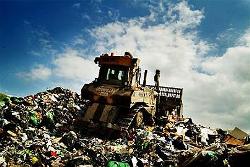 A literature review has revealed that landfill sites oxidise far more CH4 than has previously been estimated, writes Sarah Day.
A literature review has revealed that landfill sites oxidise far more CH4 than has previously been estimated, writes Sarah Day.
Geoscientist Online 29 April 2009
Landfill sites are said to be the second-largest human-made source of methane emissions in the US. The extent of global CH
4 emissions from landfill sites remains uncertain, however, due to the difficulty of calculating how much methane is oxidised before reaching the atmosphere.
Methane is produced as the waste decomposes in the absence of oxygen, and while some is collected, much of the gas passes through soils covering the landfill. Here, some is consumed by bacteria and oxidised, reducing the amount which is released into the atmosphere.
The amount of methane oxidised in this process has long been uncertain. Currently the Intergovernmental Panel on Climate Change uses the value of 0 to 10% oxidation, while the United States Environmental Protection Agency uses 10% as a default value for regulatory purposes.
These figures are questioned in a study, published in the Journal of Environmental Quality, carried out by Drs. Jeffry Chanton, David Powelson and Roger Green of Florida State University and Waste Management Inc. They reviewed and compiled literature results from 42 determinations of the fraction of methane oxidised and 30 determinations of methane oxidation rate in various soil types and landfill covers.
Their results showed that the percentage of methane oxidised can vary widely across different soil types , with mean values ranging from 22% in clayey soil to 55% in sandy soil. They obtained an overall mean value of 36% oxidisation, with a standard error of 6%.
Out of all 42 determintions of methane oxidation, only five reported a value of 10% or less, suggesting that the default 10% value should be updated. The researchers suggest that the value has been used as a default simply because the first study that attempted to find a percentage returned a value of 10%. However, since then, significant technological advances have taken place in soil engineering and cover design. These appear to have had a significant effect on the percentage of methane oxidised, suggesting that landfill sites may not contribute such a high percentage of their methane emissions to the atmosphere as was previously thought.